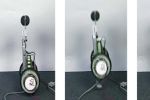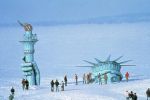Soot Happens
The bright, pristine slopes are calling your name. You head up to the mountain at sunrise, strap on your skis, and hit the first run. Only, instead of the immaculate white snow you had been dreaming about, you find the snowpacks are not as bright white as they should be, and your run is accompanied by streams of melting snow following you down the side of the mountain. The culprit? Soot. This pollutant has been darkening and melting snow-covered mountains for awhile, but the first experiments to quantify how much soot contributes to snowpack melt were only carried out recently.
It turns out soot, a by-product of burning fossil fuels, is to blame for an average temperature rise of about 1.2 degrees Fahrenheit. While that's not quite enough to melt a mogul, it is doing demonstrable damage (from the ski bunny's point of view, at least). When soot falls, it darkens the snow it lands upon. In turn, the darkened snow absorbs more of the sun's energy than whiter, cleaner snow would. Absorbing more sunlight results in a thinner snowpack, which then reflects less sunlight back into the atmosphere, leading the area to heat up even more. So, soot actually darkens snow in two ways, from its own dark color and by shrinking the snowpack to expose the dark natural ground beneath. This "soot-snow cycle" causes snow to melt up to a month earlier, and furthermore, it leads to reduced run-off in late spring and summer. Says atmospheric scientist Yun Qian, "If we can project the future -- how much water we'll be getting from the rivers and when -- then we can better plan for its many uses. Snowmelt can be up to 75 percent of the water supply, in some regions. These changes can affect the water supply, as well as aggravate winter flooding and summer droughts."
To single out soot as a snow-melting factor, and not just as part of a bundle of greenhouse gases contributing to warmer temperatures, Qian and her team used the Weather Research and Forecasting model (WRF) developed at the National Center for Atmospheric Research in Boulder, Colorado. The incredible zoom on this computer model has a resolution of up to 15 kilometers, meaning features like Killington and the soot deposits on it are better defined. Don't worry, it's not so good they can spot your neon one-suit from 1981.
Using an advanced version of WRF that also models the chemistry of aerosols (tiny atmospheric particles) and their interaction with clouds and sunlight, the team quantified the amount of soot that would fall in the Sierra Nevada, Cascade, and Rocky Mountains and how it would darken the snow throughout the year. They then extrapolated snow accumulation and melting over time.
As an experiment, the group set the model to simulate the affects of enough soot falling to double the darkening of white snow. Snow surface temperature went up 50% and the drop in snow accumulation nearly doubled. Snowpack over the central Rockies and southern Alberta, for example, dropped two to 50 millimeters over the mountains during late spring and early winter, with the most drastic changes occurring in March – sadly, just when lift ticket prices start to drop.
While skiers may be slightly affected by soot, the consequences are really most imperative for water resource managers in the western United States and Canada who plan for hydroelectricity generation, fisheries, and farming. They depend on the natural water reserves and run-off those seasonally snow-covered mountains provide. Experiments like this identify the culprit (I'm looking at you, soot) and hopefully, future developments will clean it up, so the only eye-sore on the mountain will be that blindingly bright pink one-suit.
Via: EurekAlert
Popular Tags
The Environment

| regarding | user | just commented |
|---|---|---|
| F1 car VS Powerboat VS Superbike | Karl777 | Mind you, the superbike |
| Door in the Floor Leads to Amazing Spiral Wine Dungeon | Ulyssus | If its fibreglass and of a |
| Best Obama Action Figure Ever Battles Darth Vader, Terrorists, Karaoke | Ulyssus | Where to buy and how much? I |
| F1 car VS Powerboat VS Superbike | dnf27 | It's nuts seeing how quickly |
| Door in the Floor Leads to Amazing Spiral Wine Dungeon | dnf27 | That would be the most |
Featured
The Environment
America's 50 Greenest Cities
Want to see a model for successful and rapid environmental action? Don't look to the federal government—check out your own town. Here, our list of the 50 communities that are leading the way. Does yours make the cut?








